User Guide
- Introduction
- How to use this guide
- Quick start
- Navigating the User Interface
- Command summary
- Command Syntax Guide
- Valid properties/buyers
-
Commands
- Viewing help :
help - Adding a property/buyer:
add - Listing all properties/buyers :
list - Editing a property/buyer :
edit - Viewing price chart of listed properties and/or buyers :
stat - Locating properties/buyers by name, tags and price:
find - Deleting a property/buyer :
delete - Sorting properties/buyers:
sort -
Matching properties and buyers:
match - Importing data from CSV file :
import - Exporting data to CSV file :
export - Clearing all entries :
clear - Exiting the program :
exit
- Viewing help :
- Advanced features
- FAQ
- Glossary
Introduction
PropertyWhiz helps you, a property agent, manage your properties and clients. PropertyWhiz allows you to easily access information, create visualizations, and match your properties to potential buyers.
Is this for me?
If you fit the descriptions below, then PropertyWhiz will suit you well.
- Do you face difficulties managing client information on pen and paper? With PropertyWhiz, the data you need will always be at your fingertips.
- Do you fumble with the complexities of general-purpose software like Microsoft Excel? PropertyWhiz has a simple yet powerful set of commands purpose-built for you. With a Command Line Interface (CLI), PropertyWhiz helps you complete your tasks even more efficiently.
Purpose of this guide
This guide will gently introduce you to the various features offered by PropertyWhiz. Use this guide as a tutorial to get started with PropertyWhiz. When you are proficient, you can still refer back to this document as a reference sheet.
This guide is:
- A summary of all the features offered by PropertyWhiz, and provides a high-level overview on how they operate.
- An overview of what user input is considered as valid so you can quickly get started with PropertyWhiz.
This guide is not:
- An exhaustive case study of all possible ways of using PropertyWhiz’s features.
- An exhaustive list of valid and invalid inputs as the application itself will hint you when your input is invalid.
How to use this guide
Thank you for investing your time to learn more about PropertyWhiz.
Here are some tips on how to read this guide more efficiently, so that you can improve your effectiveness in using PropertyWhiz.
Navigating the guide
- First, you can read the Quick Start section to check the compatibility of your system with PropertyWhiz. We recommend that you download PropertyWhiz and follow along with the commands introduced in this guide. Practice makes perfect and it is the best way to learn how to use PropertyWhiz!
- Before going further, do have a glance at the conventions on symbols and formatting used across this guide. If you see any unfamiliar terminology, fret not, for you can find an explanation in the glossary.
- Now that you have had an initial look at PropertyWhiz, we have a detailed listing of the user interface (UI) components here. By this step, you may have already tried out some commands in the command box. If you haven’t or don’t know what the command box is, don’t worry! The information is in the UI component listing.
- Now you are ready to take a deeper dive into our commands. We have some general guidelines on what user input is considered valid. Feel free to look through the detailed descriptions of our commands.
- We have tried our best to make the command format as intuitive and unambiguous as possible. If you have doubts, do refer to our detailed guide on command syntax.
Conventions
| Symbols | Meaning |
|---|---|
| This is general information that improves your background understanding of this guide as well as PropertyWhiz. | |
| This is additional (but not crucial) information that may help you to use PropertyWhiz more effectively. | |
| This is something important that you should be aware of. |
| Formatting | Meaning |
|---|---|
| italics | This is used to give slight emphasis to certain words. |
| boldface | This is used to emphasize certain words. The degree of emphasis is stronger than italics. |
code |
This is used to denote user input or special text. |
Quick start
![]() Supported platforms:
Supported platforms:
If you are using Microsoft Windows, macOS or Linux, then PropertyWhiz is fully compatible with your system. Follow the steps below to get started within minutes.
-
Ensure you have Java
11or above installed on your Computer. -
Download the latest
propertywhiz.jarfile from here. -
Copy the file to the folder you want to use as the home folder for your PropertyWhiz.
-
Double-click the file to start the app. The Graphical User Interface (GUI) similar to below should appear in a few seconds. PropertyWhiz comes with sample data, so you can try out our features right away.

-
PropertyWhiz has a Command Line Interface (CLI). To tell PropertyWhiz what to do, type a command into the command box at the top and press Enter to execute it. Don’t worry if you make a mistake, PropertyWhiz will tell you what went wrong and let you try again.
Some example commands you can try:-
clear: Deletes all properties/buyers. Enterclearto start from scratch! -
list: Lists all properties/buyers. -
add: Adds a property/buyer.- e.g.
add property n/Blk 123 a/123, Clementi Rd, #04-20, 1234665 s/James Lee p/61234567 e/example@email.com $/100000 t/HDB t/3rm
- e.g.
-
delete: Deletes a property/buyer shown in the current list at the given index.- e.g.
delete property 3 - e.g.
delete buyer 3
- e.g.
-
exit: Exits the app.
-
- Be assured that PropertyWhiz saves your data automatically. There is no need to save manually.
- To learn more about PropertyWhiz, refer to the Commands section below for details of each command, or the Command Summary.
Navigating the User Interface
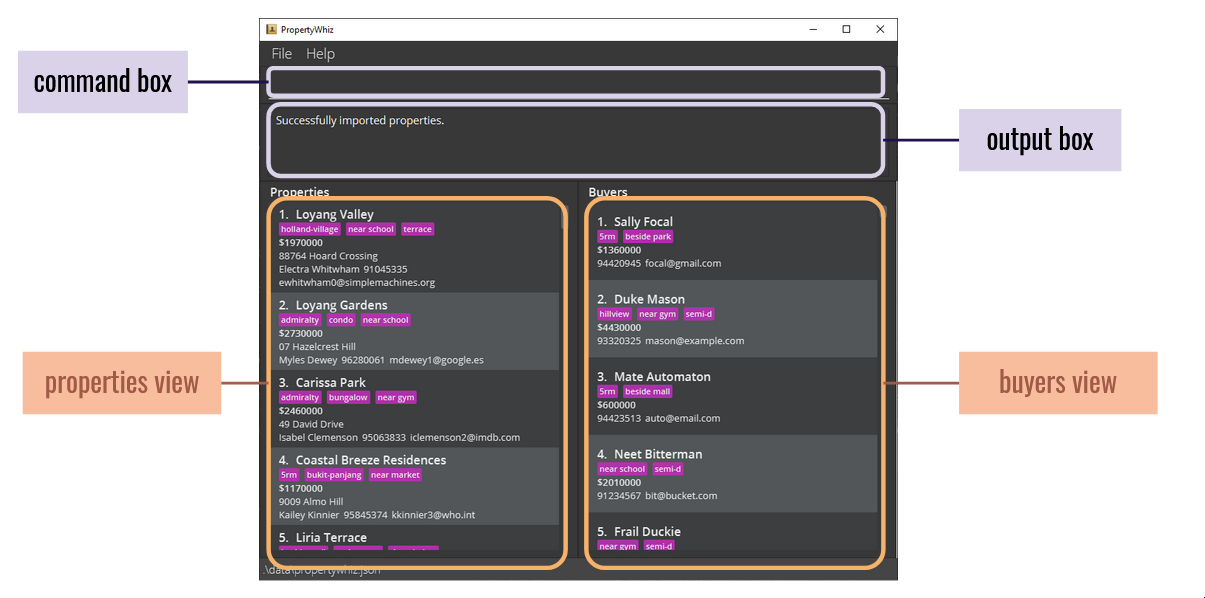
The user interface is split into the input and output sections, as well as two view columns for Properties and Buyers.
| Item | Description |
|---|---|
| Command box | This is where you enter your commands to PropertyWhiz. |
| Output box | The output box displays additional information from a command. |
| Properties view | A list of properties and their details. |
| Buyers view | A list of buyers and their details. |
Here is the breakdown of an individual property card.
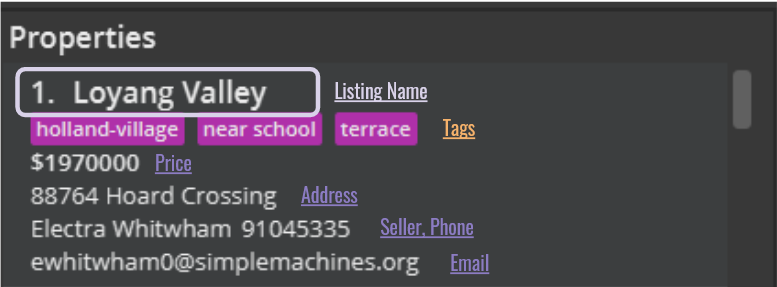
| Item | Description |
|---|---|
| Name | Name of property listing. |
| Tags | Tags describing notable qualities of the property. |
| Price | Quoted price of seller. |
| Address | Address of property listing. |
| Seller | Name of seller. |
| Phone | Phone number of seller. |
| Email of seller. |
Here is the breakdown of an individual buyer card.
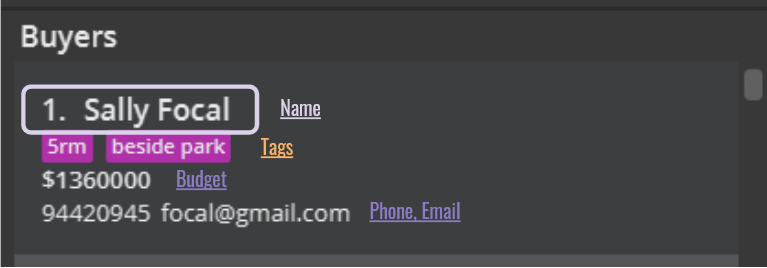
| Item | Description |
|---|---|
| Name | Name of buyer. |
| Tags | Tags describing the buyer’s preferences. |
| Budget | The buyer’s budget. |
| Phone | Phone number of buyer. |
| Email of buyer. |
Command summary
This section presents an overview of the commands you can give PropertyWhiz. Do refer to the Command Syntax Guide below to learn how to interpret the command formats, and the Commands section for a detailed explanation of each action.
| Action | Format |
|---|---|
| Help | help |
| Add |
Property add property n/PROPERTY_NAME a/PROPERTY_ADDRESS s/SELLER_NAME p/SELLER_PHONE e/SELLER_EMAIL $/PRICE [t/TAG]… Buyer add buyer n/BUYER_NAME p/BUYER_PHONE e/BUYER_EMAIL $/BUDGET [t/TAG]…
|
| List | list |
| Edit |
Property edit property INDEX [n/PROPERTY_NAME] [a/PROPERTY_ADDRESS] [s/SELLER_NAME] [p/SELLER_PHONE] [e/SELLER_EMAIL] [$/PRICE] [([t/TAG]… | [ta/TAG_TO_ADD]… [td/TAG_TO_DELETE]…)]Buyer edit buyer INDEX [n/BUYER_NAME] [p/BUYER_PHONE] [e/BUYER_EMAIL] [$/BUDGET] [([t/TAG]… | [ta/TAG_TO_ADD]… [td/TAG_TO_DELETE]…)]
|
| Stat | stat [(property | buyer)] |
| Find | find (property | buyer) [KEYWORD]… [t/TAG_TO_MATCH]… [$min/MIN_PRICE] [$max/MAX_PRICE] |
| Delete | delete (property | buyer) INDEX |
| Sort | sort (property | buyer) (price | name) (asc | desc) |
| Match | match (auto | property INDEX | buyer INDEX) |
| Import | import (property | buyer) |
| Export | export (property | buyer) |
| Clear | clear |
| Exit | exit |
Command Syntax Guide
This section helps you understand the format of the commands listed above and in the commands section. If you find this section difficult to understand, feel free to skip ahead and learn the commands by following the examples given.
- The action keywords
propertyandpropertiesare interchangeable, and likewise forbuyerandbuyers.- e.g.
find property Condocan also be entered asfind properties Condo.
- e.g.
- Words in
UPPER_CASEmust be replaced with the corresponding field by the user.
- e.g. in
add property n/PROPERTY_NAME,PROPERTY_NAMEis a parameter that can be used asadd property n/Beautiful Condo.
- e.g. in
-
[]: Items in square brackets are optional.
- e.g
n/PROPERTY_NAME [t/TAG]can be used asn/Beautiful Condo t/condoor asn/Beautiful Condo.
- e.g
-
…: Items with…after them can be repeated any number of times.
- e.g.
[t/TAG]…can be omitted, used once:t/condo, twice:t/condo t/familyor more times.
- e.g.
-
( | ): Items in round brackets()separated by|means that you can only choose 1 of the items
- e.g.
([t/TAG] | [ta/TAG_TO_ADD] [t/TAG_TO_DELETE])can be used ast/condoorta/condo td/small condobut nott/condo ta/condoort/condo td/small condo
- e.g.
- Extraneous parameters for commands that do not take in parameters (such as
help,list,exitandclear) will be ignored.
- e.g. if the command specifies
help 123, it will be interpreted ashelp.
- e.g. if the command specifies
Valid properties/buyers
This section describes the requirements of certain fields.
Property/buyer names
- Names must only contain alphanumeric characters, spaces and hyphens (
-). - Names have a maximum allowed length of 50 and cannot be blank.
- Buyers with identical names are not allowed.
Property addresses
- Addresses must only contain alphanumeric characters or the following special characters:
- spaces
- hyphens (
-) - commas (
,) - semicolons (
;) - hashes (
#)
- Addresses have a maximum allowed length of 100 and cannot be blank.
- Properties with identical addresses are not allowed.
Property prices and buyer budget
- Prices must be numbers between 4 and 9 digits (both inclusive).
- Leading zeroes will be ignored. For e.g.,
00100has 5 characters, but it only has 3 digits, not counting the leading 0s. Hence,00100is an invalid price.
Phone numbers
- Phone numbers should only contain alphanumeric characters, hyphens (
-), parentheses (()), plus signs (+) and spaces. - Phone numbers must have at least 3 characters, excluding leading and trailing spaces.
- Valid:
9123 4567(office) +65 6123 4567nil
- Invalid:
-
#123(contains invalid hash symbol)
-
- Valid:
Tags
- Tags are always optional.
- Tags must start with a letter or number, and only contain alphanumeric characters, spaces and hyphens (
-). - Tags have a maximum allowed length of 100.
Commands
Viewing help : help
Use this command if you need to access the help page.

Format: help
Adding a property/buyer: add
Use this command to add a property or buyer.
Format:
- Adding a property:
add property n/PROPERTY_NAME a/PROPERTY_ADDRESS s/SELLER_NAME p/SELLER_PHONE e/SELLER_EMAIL $/PRICE [t/TAG]… - Adding a buyer:
add buyer n/BUYER_NAME p/BUYER_PHONE e/BUYER_EMAIL $/BUDGET [t/TAG]…
Examples:
add property n/Blk 123 a/123, Clementi Rd, #04-20, S654321 s/James Lee p/(hp) 61234567 e/james@email.com $/100000 t/hdb t/3rmadd buyer n/Sam p/91234567 e/sam@email.com $/740000 t/hdb t/3rm
Visual Example:
Shown below is the output for the valid input add property n/Blk 123 a/123, Clementi Rd, #04-20, S654321 s/James Lee p/(hp) 61234567 e/james@email.com $/100000 t/hdb t/3rm.
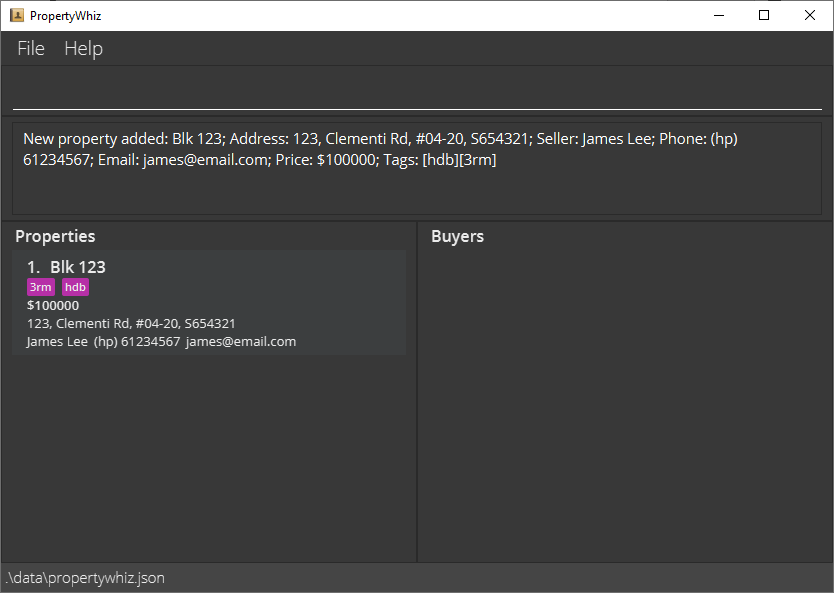 You will see the newly added property at the top of the property listing.
You will see the newly added property at the top of the property listing.
See the section Valid properties/buyers for more details about the different fields.

Listing all properties/buyers : list
Use this command to view the full list of properties and buyers stored in PropertyWhiz.
Format: list
![]() Tip:
Tip:
As list resets all active filters and sort orderings, one of the most common uses of the list command to reset the display lists to display all the properties and buyers in PropertyWhiz.
Some places where you might want to make use of the list are when:
-
finding properties/buyers based on certain criteria -
sorting properties/buyers -
matching properties and buyers together
You may wish to use list before any of these commands in order to process the full list of data within PropertyWhiz.
You may wish to use list after any of these commands in order to return to the full list.
Editing a property/buyer : edit
Use this command to update the details of a property or buyer.
Format:
- Editing a property:
edit property INDEX [n/PROPERTY_NAME] [a/PROPERTY_ADDRESS] [s/SELLER_NAME] [p/SELLER_PHONE] [e/SELLER_EMAIL] [$/PRICE] [([t/TAG]… | [ta/TAG_TO_ADD]… [td/TAG_TO_DELETE]…)] - Editing a buyer:
edit buyer INDEX [n/BUYER_NAME] [p/BUYER_PHONE] [e/BUYER_EMAIL] [$/BUDGET] [([t/TAG]… | [ta/TAG_TO_ADD]… [td/TAG_TO_DELETE]…)]
This command edits the property/buyer at a specified INDEX. The index refers to the index number shown in the displayed property/buyer list. The index must be a positive number i.e. 1, 2, 3, …
- At least one of the optional fields must be provided.
- Like
add, tags added viaeditwill be automatically converted to lowercase. - Use the
t/option to overwrite the list of tags, useta/ortd/to add or remove tags. - You can remove all the property/buyer’s tags by typing
t/without specifying any tags after it.
Examples:
-
edit property 1 p/91234567 e/johndoe@example.com- Edits the phone number and email address of the 1st property to be
91234567andjohndoe@example.comrespectively.
- Edits the phone number and email address of the 1st property to be
-
edit property 2 n/Blk 298 Toa Payoh Central t/- Edits the name of the 2nd property to be
Blk 298 Toa Payoh Centraland clears all existing tags.
- Edits the name of the 2nd property to be
-
edit buyer 1 p/91234567 e/johndoe@example.com- Edits the phone number and email address of the 1st buyer to be
91234567andjohndoe@example.comrespectively.
- Edits the phone number and email address of the 1st buyer to be
-
edit property 1 ta/4rm ta/near mrt- Edits the tag list of the 1st property by adding two tags called “4rm” and “near mrt” if they are not already present.
-
edit property 1 ta/4rm td/near mrt- Edits the tag list of the 1st property by adding a tag called “4rm” if not already present and removing a tag called “near mrt” if present.
edit property 1 t/near school ta/4rm td/near mrt You cannot override the tag list with t/ while editing it with ta/ or td/ at the same time. As the intention is unclear, PropertyWhiz will display an error message.
See the section Valid properties/buyers for more details about the different fields.
Viewing price chart of listed properties and/or buyers : stat
PropertyWhiz allows you to visualize the prices of properties and buyers. Use this command to view a price chart of the currently displayed properties and/or buyers.
Format:
- View price chart of properties and buyers:
stat - View price chart of properties:
stat property - View price chart of buyers:
stat buyer
Visual Example:
The below image shows a sample output from the command stat.
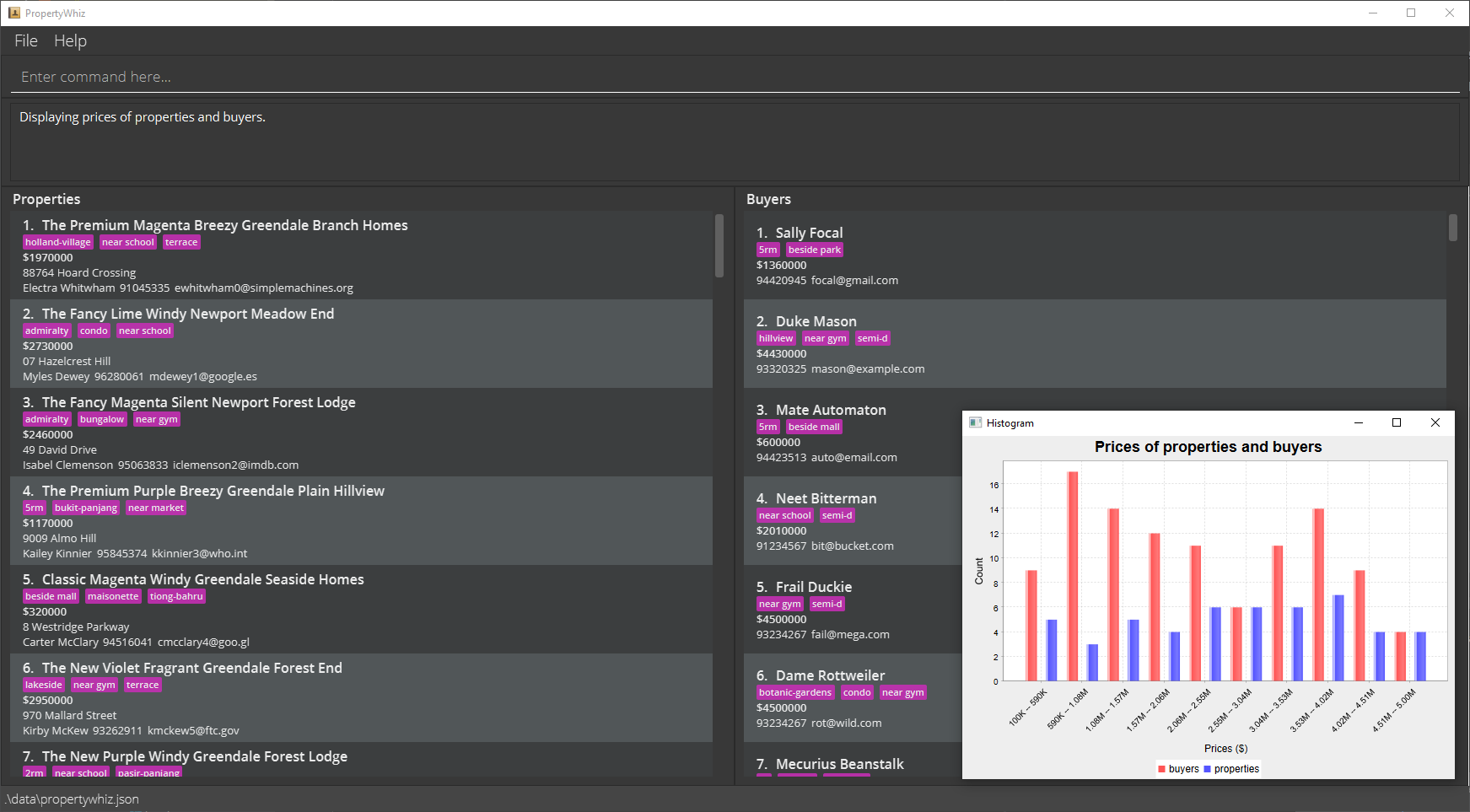 Since neither the property nor buyer list is empty, you should see the combined chart of both properties and buyers.
The price chart shows the number of properties and buyers for each price range.
Since neither the property nor buyer list is empty, you should see the combined chart of both properties and buyers.
The price chart shows the number of properties and buyers for each price range.
stat automatically presents the only buyers or only properties view.
Locating properties/buyers by name, tags and price: find
Use this command to filter or search properties or buyers. This command filters displayed properties or buyers whose names contain any of the given keywords, has all the specified tags and whose price/budget is within the specified range.
Format:
- Finding properties:
find property [KEYWORD]… [t/TAG_TO_MATCH]… [$min/MIN_PRICE] [$max/MAX_PRICE] - Finding buyers:
find buyer [KEYWORD]… [t/TAG_TO_MATCH]… [$min/MIN_BUDGET] [$max/MAX_BUDGET]
- This command acts on the current list of properties and buyers.
- e.g. If
find property hillviewreturn propertiesHillviewandHillview Rise, then applying another find commandfind property grovewill return an empty list, even if PropertyWhiz has a propertyGrove.
- e.g. If
- The order of the keywords does not matter. e.g.
Hillview Risewill matchRise Hillview - Only full words will be matched e.g.
Hillwill not matchHillview - The tag and keyword search are both case-insensitive, e.g. both
t/mrt,t/MRTwill match themrttag. - Properties/buyers matching at least one keyword will be returned.
- e.g.
find property Hillview Risewill return propertiesHillview Grove,Rise Rivervale
- e.g.
- Only properties/buyers that match all the tags will be returned.
- e.g.
find property t/4rm t/near schoolwill only return properties with both4rmandnear schooltags.
- e.g.
- The price search is inclusive of the specified number.
- e.g.
find property $min/10000will return properties with price at least $10000. - e.g.
find property $max/100000will return properties with price at most $100000.
- e.g.
Examples:
-
find buyer Sally- Returns buyers
sallyandSally Brown
- Returns buyers
-
find property Jurong t/4rm t/near school- Returns properties
jurong [4rm] [near school] [near mrt]andJurong East [4rm] [near school] [near mrt]but notjurong [4rm] [near mrt]
- Returns properties
-
find buyer $min/200000 $max/3000000- Returns buyers with budgets between $200000 and $3000000
Visual Example:
Shown below is the output for the valid input find buyer $min/100000 $max/1000000.
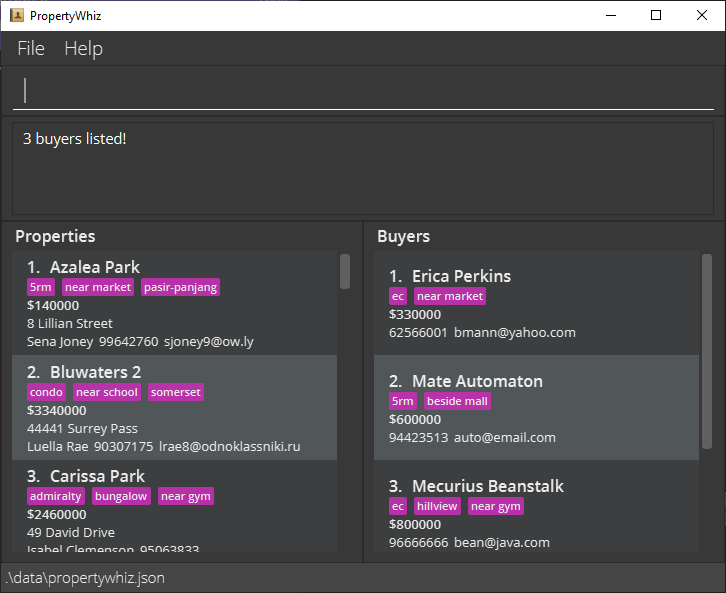 The buyer list is filtered to only show buyers with budgets between $100000 and $1000000.
The buyer list is filtered to only show buyers with budgets between $100000 and $1000000.
Deleting a property/buyer : delete
Use this command to delete a property or buyer from PropertyWhiz.
Format: delete (property | buyer) INDEX
This command deletes the property/buyer at a specified INDEX. The index refers to the index number shown in the displayed property/buyer list. The index must be a positive number i.e. 1, 2, 3, …
Examples:
-
listfollowed bydelete property 2deletes the 2nd property in PropertyWhiz. -
find property East Coastfollowed bydelete property 1deletes the 1st property in the results of thefindcommand.
Sorting properties/buyers: sort
Use this command to sort the properties or buyers currently displayed. This for example, allows you to view buyers with the highest budget.
Format: sort (property | buyer) (price | name) (asc | desc)
- Selecting
pricewill sort properties by price and buyers by budget. - Selecting
namewill sort properties and buyers based on their names. - Selecting
asc(ascending) will sort budgets/prices from lowest to highest or names in alphabetical order. - Selecting
desc(descending) will sort budgets/prices from highest to lowest or names in reverse alphabetical order.
Examples:
-
sort buyer price desc- Sorts the list of buyers by their budgets from highest to lowest.
-
sort property name asc- Sorts the list of properties by their names in alphabetical order.
Visual Example:
Shown below is the output for the valid input sort buyer price desc after previously having entered
find buyer $min/100000 $max/1000000.
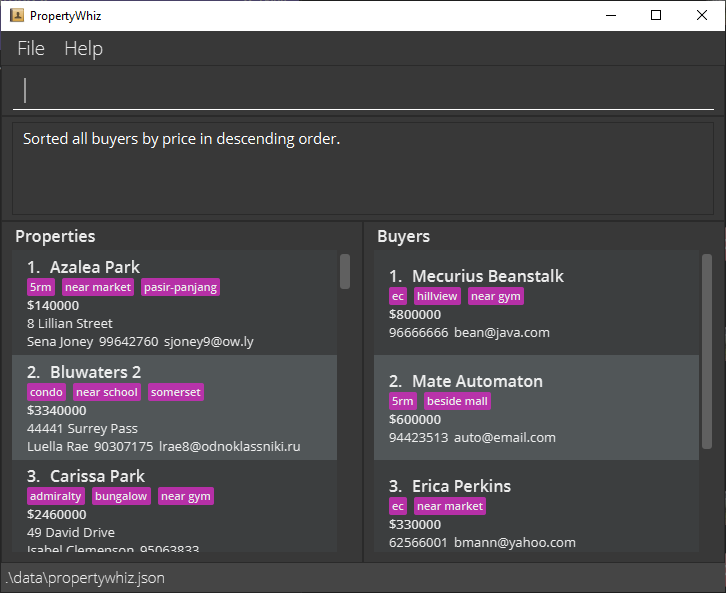 The buyer list now contains only buyers whose budgets are between $100000 and $1000000. Furthermore, the buyers are sorted in decreasing order of budget. For instance, Mecurius has the highest budget of $800000.
The buyer list now contains only buyers whose budgets are between $100000 and $1000000. Furthermore, the buyers are sorted in decreasing order of budget. For instance, Mecurius has the highest budget of $800000.
Matching properties and buyers: match
PropertyWhiz is able to automatically match properties and buyers to one another. This tells you which buyers are most suitable for which properties. By using this command, you can make better recommendations to your clients.
Format: match (auto | property INDEX | buyer INDEX)
One to many matching of property to buyers
This command matches compatible buyers to a specified property, and displays them in descending order of desirability.
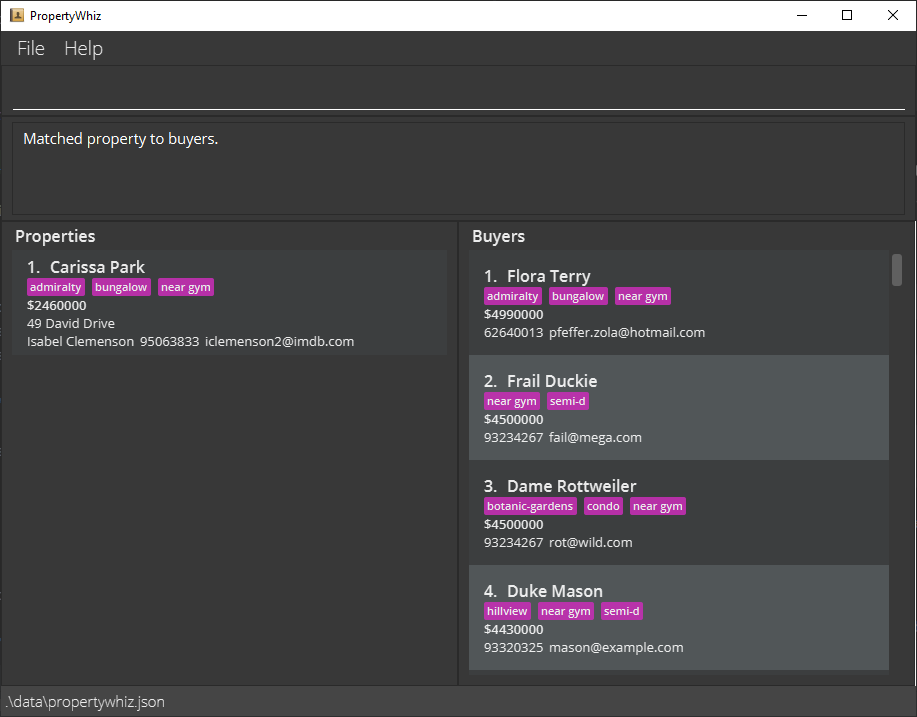
Format: match property INDEX
- A buyer is compatible with a property if the buyer’s budget is greater than or equal to the property’s selling price.
- When 2 buyers, say
AandBare both compatible with a property, thenAis more desirable thanBifAhas more tags in common with the property thanB. This is because a buyer’s tags represent what the buyer would want in a property, and a property’s tags represent the features the property has to offer. - When 2 buyers have the same number of tags in common with a property, the buyer with a higher budget is ranked higher in desirability.
find command to filter the buyer list, then the potential matches for match property 1 (the first displayed property) will only come from the filtered buyer list.
You can use the
list command to display all the available buyers before using match property. This will find compatible buyers from the full pool of available buyers.
Example:
-
match property 2will match all displayed buyers with the second displayed property. Suppose the second displayed property has a selling price of$1,000,000and has tags4rm,near school.- Price Compatibility:
- Compatible buyers:
- All buyers whose budget is at least
$1,000,000 - e.g. A buyer whose budget is
$1,100,000is compatible
- All buyers whose budget is at least
- Incompatible buyers:
- All buyers whose budget is lower than
$1,000,000
- All buyers whose budget is lower than
- Compatible buyers:
- Tag Compatibility:
- Suppose we have 3 buyers:
- Richard has tags
5rm,far from school - Sam has tag
4rm - Tim has tags
4rm,near school
- Richard has tags
- Tim has the greatest number of tags in common and is hence the most desirable buyer match, the opposite is true for Richard.
- Order of tag compatibility (most to least compatible): Tim, Sam, Richard.
- Suppose we have 3 buyers:
- Price Compatibility:
One to many matching of buyer to properties
This command matches compatible properties to a specified buyer, and displays them in descending order of desirability.
Format: match buyer INDEX
- A property is compatible with a buyer if the property’s selling price is lower than the buyer’s budget, i.e. the property is within the budget of the buyer.
- When 2 properties, say
AandBare both compatible with a buyer, thenAis more desirable thanBifAhas more tags in common with the buyer thanB. - When 2 properties have the same number of tags in common with a buyer, the property with a lower selling price is ranked higher in desirability, in other words, cheaper is better.
- Similar to
match property, the matching formatch buyeris done on the currently displayed properties.
Example:
-
match buyer 2will match all displayed properties with the second displayed buyer. Suppose the second displayed buyer has budget of$1,000,000and has tags4rm,near school.- Budget Compatibility:
- All properties with selling price of at most
$1,000,000are compatible
- All properties with selling price of at most
- Tag Compatibility:
- Suppose we have 3 properties:
- Dee Gardens has tags
5rm,far from school - Olive Gardens has tag
4rm - Pear Gardens has tags
4rm,near school
- Dee Gardens has tags
- Order of tag compatibility (most to least compatible): Pear Gardens, Olive Gardens, Dee Gardens.
- Pear Gardens has the greatest number of tags in common and is hence the most desirable property match, the opposite is true for Dee Gardens.
- Suppose we have 3 properties:
- Budget Compatibility:
Intelligent matching of properties and buyers
The match auto command instructs PropertyWhiz to automatically match all displayed buyers and properties. This is unlike the previous sections when the matching is done on a single property or a single buyer. With the match auto command, all available properties and buyers will be intelligently matched, allowing you to engage multiple clients at once.
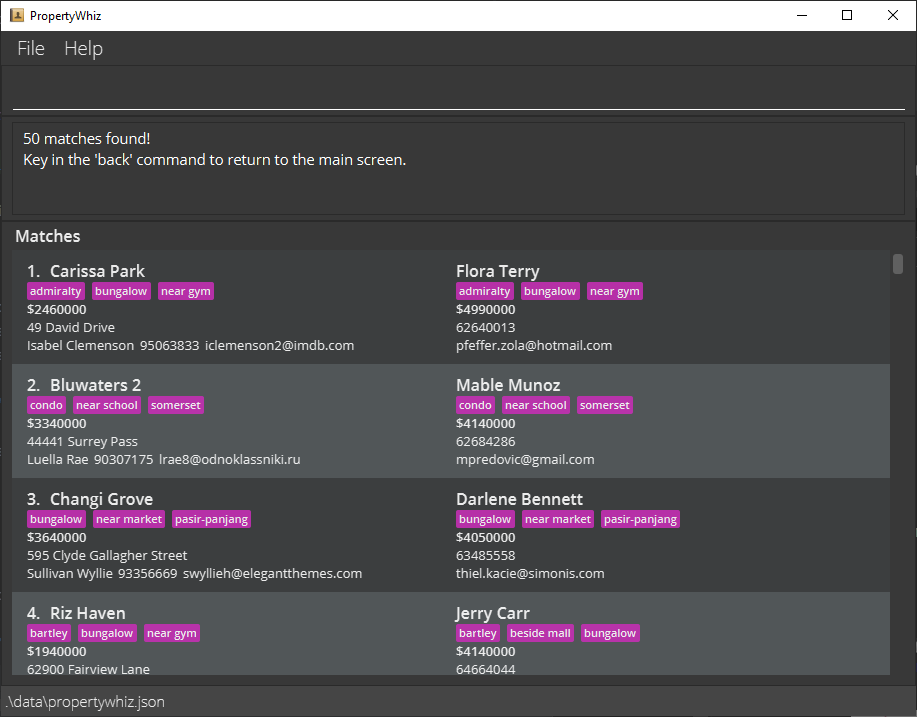
Format: match auto
Upon entering match auto, PropertyWhiz will intelligently pair the displayed properties and buyers based on their compatibility. The matches will then be displayed to you starting with the most compatible pairings at the top.
PropertyWhiz determines compatibility based on the number of tags in common, the buyer’s budget, as well as the property price. Matches where the buyer and property have more tags in common are considered more compatible. Likewise for matches where the property price is within the buyer’s budget.
After running match auto, enter back into the command box to return to the previously shown list of buyers and properties.
Importing data from CSV file : import
Use this command to import buyers or properties from a CSV file. Imported items will be added to the front of the list.
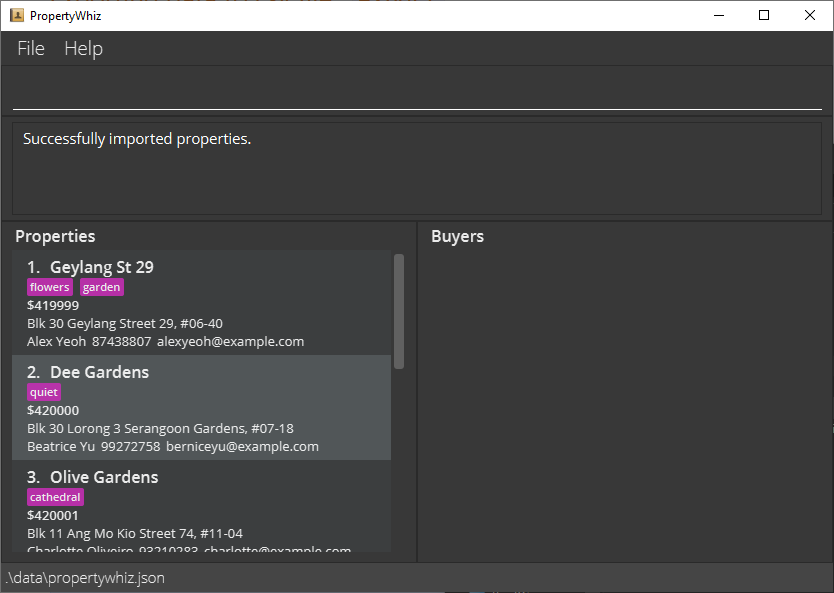
Format: import (buyer | property)
- You can select the import file location from a pop-up dialog box.
- The buyer or property list imported must be valid. Some criteria are as follows:
- No duplicates
- All fields valid
- No missing fields
- The CSV must begin with a header that includes the names of each column.
See below for example CSV files.
Exporting data to CSV file : export
Use this command to export currently displayed buyers or properties to a CSV file.
Format: export (buyer | property)
- You can select the export file location from a pop-up dialog box.
Example CSV output of export property
"Name","Address","Seller Name","Phone","Email","Price","Tags"
"Geylang St 29","Blk 30 Geylang Street 29, #06-40","Alex Yeoh","87438807", "alexyeoh@example.com","419999","flowers,garden"
"Dee Gardens","Blk 30 Lorong 3 Serangoon Gardens, #07-18","Beatrice Yu","99272758", "berniceyu@example.com","420000","quiet"
"Olive Gardens","Blk 11 Ang Mo Kio Street 74, #11-04","Charlotte Oliveiro","93210283", "charlotte@example.com","420001","cathedral"
"Pear Gardens","Blk 436 Serangoon Gardens Street 26, #16-43","David Li","91031282", "lidavid@example.com","420002","near cbd"
"Tampa Bay","Blk 47 Tampines Street 20, #17-35","Irfan Ibrahim","92492021", "irfan@example.com","420003","noisy,party"
Example CSV output of export buyer
"Name","Phone","Email","Budget","Tags"
"Sally Focal","94420945","focal@gmail.com","419999","flowers,near school,garden"
"Duke Mason","93320325","mason@example.com","420000","4rm"
"Mate Automaton","94423513","auto@email.com","420001","near cdb"
"Neet Bitterman","91234567","bit@bucket.com","420002","huge house,noisy,party"
"Frail Duckie","93234267","fail@mega.com","420003","tiny,1rm"
Clearing all entries : clear
Use this command to delete all existing data permanently from PropertyWhiz. You can use this command to clear sample data loaded the first time you use PropertyWhiz.
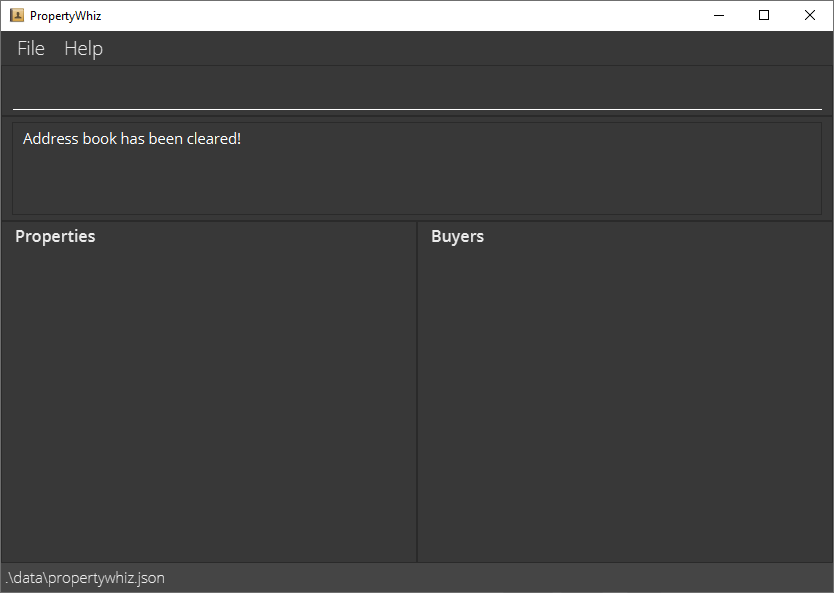
Format: clear
Exiting the program : exit
Use this command to exit the PropertyWhiz. Your data will be automatically saved.
Format: exit
Advanced features
This section contains features intended for advanced users.
Editing the data file
PropertyWhiz’s data are saved as a JSON (JavaScript Object Notation) file [JAR file location]/data/propertywhiz.json. Advanced users are welcome to update data directly by editing that data file.
Multi-command input
You may copy and paste multiple lines of commands into the command box. Press the Enter key to execute the first command and autofill the next into the command box. This continues until you enter a different command or all commands have been executed.
FAQ
Q: How do I transfer my data to another Computer?
A: Simply install the app on the other computer and overwrite the empty data file it creates with the data file located at your previous PropertyWhiz home folder.
Glossary
| Word | Meaning |
|---|---|
| Command Line Interface (CLI) | Text-based user interface |
| Graphical User Interface (GUI) | User interface that allows users to interact via mouse and graphics |
| Alphanumeric | Containing letters and numbers only |
| CSV file | Comma-separated values file, a file format Microsoft Excel can export to |
| JAR file | Java ARchive file, an application file format for Java programs |